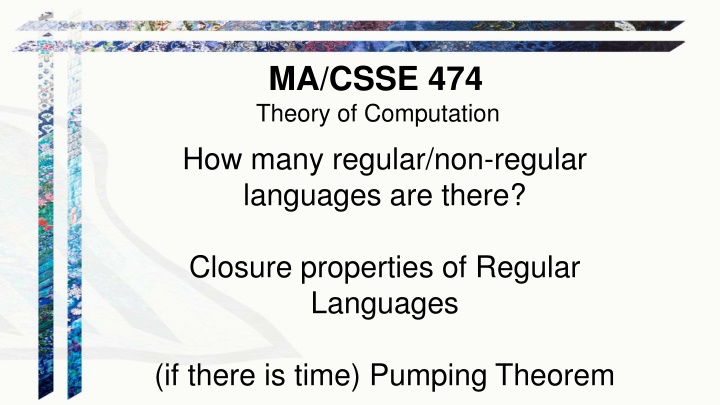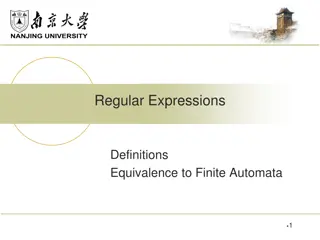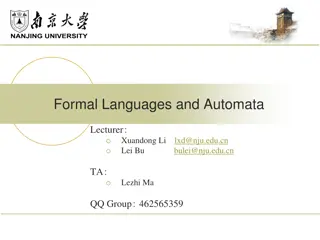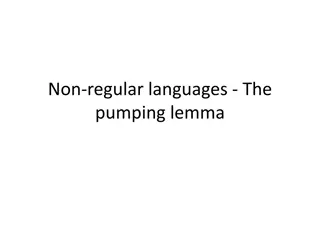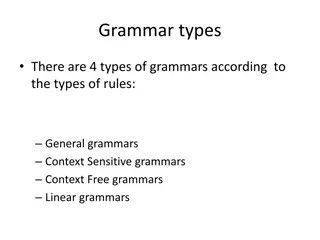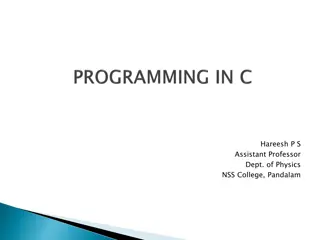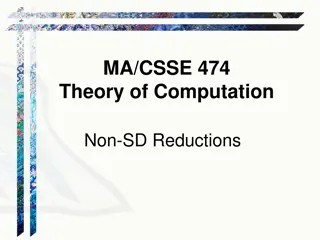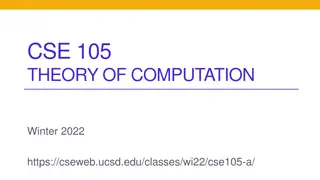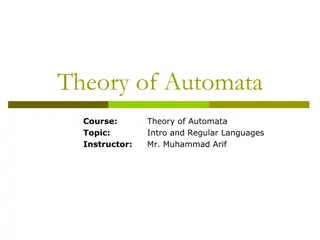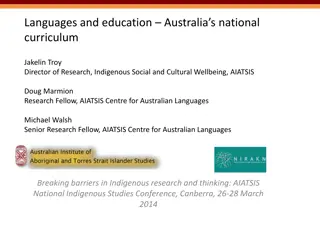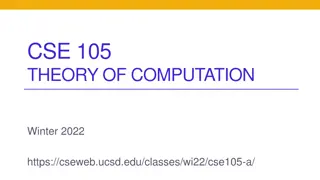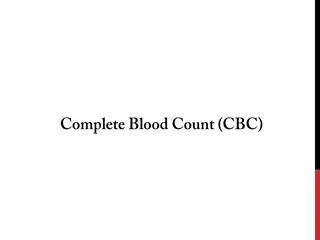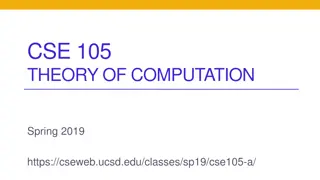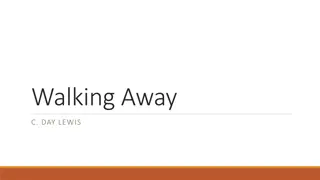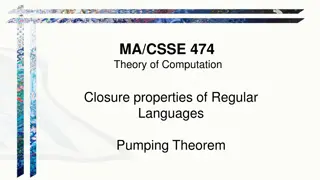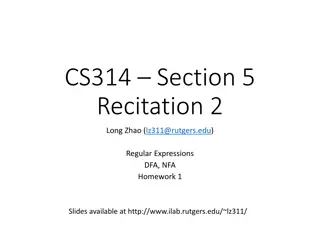Theory of Computation: Regular Languages Count
Exploring regular and non-regular languages, closure properties, and the Pumping Theorem. Understanding the countably infinite nature of regular languages and comparing regular to nonregular languages.
Download Presentation

Please find below an Image/Link to download the presentation.
The content on the website is provided AS IS for your information and personal use only. It may not be sold, licensed, or shared on other websites without obtaining consent from the author.If you encounter any issues during the download, it is possible that the publisher has removed the file from their server.
You are allowed to download the files provided on this website for personal or commercial use, subject to the condition that they are used lawfully. All files are the property of their respective owners.
The content on the website is provided AS IS for your information and personal use only. It may not be sold, licensed, or shared on other websites without obtaining consent from the author.
E N D
Presentation Transcript
MA/CSSE 474 Theory of Computation How many regular/non-regular languages are there? Closure properties of Regular Languages (if there is time) Pumping Theorem
Your Questions? Previous class days' material Reading Assignments HW 7 problems Anything else
474 Difficulty Timeline (my opinion, ymmv)
How Many Regular Languages? Theorem: The number of regular languages over any nonempty alphabet is countably infinite . Proof: Upper bound on number of regular languages: number of DFSMs (or regular expressions). Lower bound on number of regular languages: {a},{aa},{aaa},{aaaa},{aaaaa},{aaaaaa}, are all regular. That set is countably infinite.
Are Regular or Nonregular Languages More Common? There is a countably infinite number of regular languages. There is an uncountably infinite number of different languages over any nonempty alphabet . So there are many more nonregular languages than there are regular ones.
Languages: Regular or Not? Recall our intuition: a*b* is regular. AnBn = {anbn: n 0} is not. {w {a, b}* : every a is immediately followed by b} is regular. {w {a, b}* : every a has a matching b somewhere} is not. How do we show that a language is regular? List some ways for each show that a language is not regular?
Showing that a Language is Regular Theorem: Every finite language L is regular. Proof: If L is the empty set, then it is defined by the regular expression and so is regular. If L is a nonempty finite language, composed of the strings s1, s2, sn for some positive integer n, then it is defined by the regular expression: s1 s2 sn So L is regular.
Finiteness - Theoretical vs. Practical Any finite language is regular. The size of the language doesn't matter. Parity Checking Soc. Sec. # Checking But, from an implementation point of view, it very well may. When is an FSM a good way to encode the facts about a language? FSM s are good at looking for repeating patterns. They don't bring much to the table when the language is just a set of unrelated strings.
Regular Does Not Always Mean Tractable Let = {12, 13, 21, 23, 31, 32}. Let L be the language of strings that correspond to successful move sequences. The shortest string in L has length 264 -1 * There is an FSM that accepts L: *See http://en.wikipedia.org/wiki/Tower_of_Hanoi, especially the recursive solution, which (as you can see by means of a simple recurrence relation) requires 2n -1 moves if there are n disks
To Show that a Language L is Regular We can do any of the following: Construct a DFSM that accepts L. Construct a NDFSM that accepts L. Construct a regular expression that defines L. Construct a regular grammar that generates L. Show that there are finitely many equivalence classes under L. Show that L is finite. Use one or more closure properties.
Closure Properties of Regular Languages The first three are easy: definition of regular expressions. Union Concatenation Kleene star We have done, complement, intersection, reverse. Difference? Complement Intersection Difference Read about Letter Substitution. Reverse Letter substitution
Closure of the Regular Languages Under Intersection In HW5, you showed this directly using a DFSM construction. Now we derive it form other closure properties L1L2 L1 L2 = Write this in terms of operations for which we have already proved regular language closure: Union Concatenation Kleene star Complementation
Closure of Regular Languages Under Difference L1 - L2 = L1 L2
Dont Try to Use Closure Backwards One Closure Theorem: If L1 and L2 are regular, then so is L = L1 L2 But if L1 L2 is regular, what can we say about L1 and L2? L = L1 L2 {ab} = {ab} {a b}* (L1 and L2 are regular) {ab} = {ab} {anbn, n 0} (they may not be regular)
Dont Try to Use Closure Backwards Another Closure Theorem: If L1 and L2 are regular, then so is L = L1L2 But if L2 is not regular, what can we say about L? L = L1L2 {abanbn : n 0} = {ab} {anbn : n 0} L(aaa*) = {a}* {ap: p is prime}
How to Show that a Language is Not Regular Every regular language can be accepted by some FSM. It can only use a finite amount of memory to record essential properties. Example: AnBn = {anbn, n 0} is not regular
Show that a Language is Not Regular The only way to generate/accept an infinite language with a finite description is to use: Kleene star (in regular expressions), or cycles (in automata). This forces some kind of simple repetitive cycle within the strings. Example: ab*a generates aba, abba, abbba, abbbba, etc. Example: {an : n 1 is a prime number} is not regular.
Exploiting the Repetitive Property If an FSM with n states accepts at least one string of length n, how many different strings does it accept? L = bab*ab b a b b b b a b xyz xy*z must be in L. So L includes: baab, babab, babbab, babbbbbbbbbbab
Theorem Long Strings Theorem: Let M = (K, , , s, A) be any DFSM. If M accepts any string of length |K| or greater, then that string will force M to visit some state more than once (thus traversing at least one loop). Proof:M must start in one of its states. Each time it reads an input character, it visits some state. So, in processing a string of length n, M does a total of n + 1 state visits. If n+1 > |K|, then, by the pigeonhole principle, some state must get more than one visit. So, if n |K|, then M must visit at least one state more than once.
The Pumping Theorem* for Regular Languages If L is regular, then every long string in L is "pumpable". Formally, if L is a language over , (L is regular) ( k 1 such that ( strings w L, (|w| k ( x, y, z (w = xyz, |xy| k, y , and q 0 (xyqz is in L)))))) Write this in contrapositive form. Don't look ahead to the next slide yet. * a.k.a. "the pumping lemma". We will use the terms interchangeably. What if L has no strings whose lengths are greater than k?
Using The Pumping Theorem to show that L is not Regular: We use the contrapositive of the theorem: If some long enough string in L is not "pumpable", then L is not regular. What we need to show in order to show L non-regular: ( k 1 ( a string w L (|w| k and ( x, y, z((w = xyz |xy| k y ) (L is not regular) . q 0 (xyqz L)))))) Before our next class meeting: Be sure that you are convinced that this really is the contrapositive of the pumping theorem.
Using The Pumping Theorem to show that L is not Regular: We use the contrapositive of the theorem: If some long enough string in L is not "pumpable", then L is not regular. What we need to show in order to show L non-regular: ( k 1 ( a string w L (|w| k and ( x, y, z((w = xyz |xy| k y ) L is not regular . Before our next class meeting: Be sure that you are convinced that this really is the contrapositive of the pumping theorem. q 0 (xyqz L))))))
A way to think of it: adversary argument (following J.E. Hopcroft and J.D.Ullman) Given the language L you want to prove non-regular: 1. The "adversary" picks k, the constant mentioned in the theorem. We must be prepared for any positive integer to be picked, but once it is chosen, the adversary cannot change it. 2. We select a string w L (whose length is at least k) that cannot be "pumped". 3. The adversary breaks w into w=xyz, subject to the constraints |xy| k andy . Our choice of w must take into account that any such x and y can be chosen. 4. We must (for possible each way w can be broken up into xyz) produce a single number q 0 such that xyqz L. Note carefully what we get to choose and what we do not get to choose.
Example: {anbn: n 0} is not Regular k is the number from the Pumping Theorem. We don't get to choose it. Choose w to be a k/2 b k/2 ( long enough ). 12 a a a a a a a a a a b b b b b b b b b b xyz Adversary chooses x, y, z with the required properties: |xy| k, y , We must show q 0 (xyqz L). For each case, we must find at least one value of q that takes xyqz outside the language L. The most common q values to use are q=0 and q=2. Three cases to consider: y entirely in region 1: y partly in region 1, partly in 2: y entirely in region 2:
A Complete Proof We prove that L = {anbn: n 0} is not regular If L were regular, then there would exist some k such that any string w where |w| k must satisfy the conditions of the theorem. Let w = a k/2 b k/2 . Since |w| k, w must satisfy the conditions of the pumping theorem. So, for some x, y, and z, w = xyz, |xy| k, y , and q 0, xyqz is in L. We show that no such x, y, and z exist. There are 3 cases for where y could occur: We divide w into two regions: aaaaa ..aaaaaa | bbbbb ..bbbbbb | 2 1 So y can fall in: (1): y = ap for some p. Since y , p must be greater than 0. Let q = 2. The resulting string is ak+pbk. But this string is not in L, since it has more a s than b s. (2): y = bp for some p. Since y , p must be greater than 0. Let q = 2. The resulting string is akbk+p. But this string is not in L, since it has more b s than a s. (1, 2): y = apbr for some non-zero p and r. Let q = 2. The resulting string will have interleaved a s and b s, and so is not in L. There exists one long string in L for which no pumpable x, y, z exist. So L is not regular.
What You Should Write (read these details later) We prove that L = {anbn: n 0} is not regular Let w = a k/2 b k/2 . (If not completely obvious, as in this case, show that w is in fact in L.) aaaaa ..aaaaaa| bbbbb ..bbbbbb 1 | 2 There are three possibilities for y: (1): y = ap for some p. Since y , p must be greater than 0. Let q = 2. The resulting string is ak+pbk. But this string is not in L, since it has more a s than b s. . (2): y = bp for some p. Since y , p must be greater than 0. Let q = 2. The resulting string is akbk+p. But this string is not in L, since it has more b s than a s. (1, 2): y = apbr for some non-zero p and r. Let q = 2. The resulting string will have interleaved a s and b s, and so is not in L. Thus L is not regular.
Example: {anbn: n 0} is not Regular k is the number from the Pumping Theorem. We don't get to choose it. Choose w to be a k/2 b k/2 ( long enough ). 12 a a a a a a a a a a b b b b b b b b b b xyz Adversary chooses x, y, z with the required properties: |xy| k, y , We must show q 0 (xyqz L). For each case, we must find at least one value of q that takes xyqz outside the language L. The most common q values to use are q=0 and q=2. Three cases to consider: y entirely in region 1: y partly in region 1, partly in 2: y entirely in region 2:
A Complete Proof We prove that L = {anbn: n 0} is not regular If L were regular, then there would exist some k such that any string w where |w| k must satisfy the conditions of the theorem. Let w = a k/2 b k/2 . Since |w| k, w must satisfy the conditions of the pumping theorem. So, for some x, y, and z, w = xyz, |xy| k, y , and q 0, xyqz is in L. We show that no such x, y, and z exist. There are 3 cases for where y could occur: We divide w into two regions: aaaaa ..aaaaaa| bbbbb ..bbbbbb 1 | 2 So y can fall in: (1): y = ap for some p. Since y , p must be greater than 0. Let q = 2. The resulting string is ak+pbk. But this string is not in L, since it has more a s than b s. (2): y = bp for some p. Since y , p must be greater than 0. Let q = 2. The resulting string is akbk+p. But this string is not in L, since it has more b s than a s. (1, 2): y = apbr for some non-zero p and r. Let q = 2. The resulting string will have interleaved a s and b s, and so is not in L. There exists one long string in L for which no pumpable x, y, z exist. So L is not regular.
What You Should Write (read these details later) We prove that L = {anbn: n 0} is not regular Let w = a k/2 b k/2 . (If not completely obvious, as in this case, show that w is in fact in L.) aaaaa ..aaaaaa| bbbbb ..bbbbbb 1 | 2 There are three possibilities for y: (1): y = ap for some p. Since y , p must be greater than 0. Let q = 2. The resulting string is ak+pbk. But this string is not in L, since it has more a s than b s. . (2): y = bp for some p. Since y , p must be greater than 0. Let q = 2. The resulting string is akbk+p. But this string is not in L, since it has more b s than a s. (1, 2): y = apbr for some non-zero p and r. Let q = 2. The resulting string will have interleaved a s and b s, and so is not in L. Thus L is not regular.
A better choice for w Second try. A choice of w that makes it easier: Choose w to be akbk (We get to choose any w whose length is at least k). 1 2 a a a a a a a a a a | b b b b b b b b b b xyz We show that there is no x, y, z with the required properties: |xy| k, y , q 0 (xyqz is in L). Since |xy| k, y must be in region 1. So y = ap for some p 1. Let q = 2, producing: ak+pbk which L, since it has more a s than b s. We only have to find one q that takes us outside of L.
Recap: Using the Pumping Theorem If Lis regular, then every long string in L is pumpable. To show that L is not regular, we find one long string that isn t. I.e., to use the Pumping Theorem to show that a language L is not regular, we must: 1. Choose a string w where |w| k. Since we do not know what k is, we must describe w in terms of k. 2. Divide the possibilities for y into a set of equivalence classes that can be considered together. 3. For each such class of possible y values where |xy| k and y : Choose a value for q such that xyqz is not in L.
